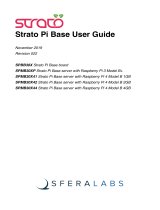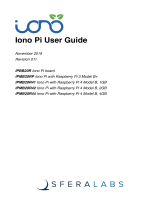Page is loading ...

Mini Tower Kit for Raspberry Pi 4B
Shanghai Kunlai Electronic Technology Co., Ltd.
Description
Mini Tower Case is made of ABS material, with very high precision, and the 45-degree OLED
screen display angle is more convenient to observe system information.
The screen holder adopts a quick-release design, and the interior of the shell includes a
design for arranging cables, which is convenient for arranging cables.
The interface adopts with a fool-proof design to avoid problems caused by wrong wiring, the
installation is simpler and more convenient.
The screen driver board contains RGB three-color programmable LED ambient light, which
can better render the light color according to your own needs.
The ice tower radiator included in the kit can not only provide good heat dissipation, but also
increase the appearance. A non-slip rubber strip is added at the bottom to prevent it from
being more stable and firm on a smooth desktop.
Features
* ABS Material and Acrylic
* Colorful mood lights
* Adjustable fan light
* 0.96-inch OLED Display (I2C protocol)
* OLED bracket adopts quick release design for easy installation and removal
* Precise positioning of holes
* Ice tower radiator strong heat dissipation
* Inside the housing contains a cable management rack
* Easy wiring and easy cable management

Specifications:
Edge expansion board: 40Pin
Ice tower cooler:
* Metal and Copper
OLED Display:
* Resolution: 128x64 pixel
* Default register address: 0x3c
* INPUT: 3.3V
Mood Light:
* WS281x programmable LED
* INPUT:3.3V~5V
4010Fan:
* INPUT:3.3~5.25V
* Consuming: 0.06mA
* Driven by PWM signal
* Freq:50Hz
* Duty Cycle range:0~255
Power supply requirement:
* INPUT: 5V@3A at least
Case:
* Materials: ABS plastic and Acrylic
* Screws: M2.5

Easy to access TF card

OLED Display system information
NOTE: need to install driver and programming...

Good Heat Dissipation with Ice Tower Cooler
ABS case with anti-slipper robber pad and flat heat screws.

Easy to tidy up wires.

How to assemble

Package Includes
1 * Mini Tower Kit for Raspberry Pi 4B.
NOTE: Raspberry Pi 4B mainboard is not included, Additional
purchase required

How to enable OLED Display?
We assume you are using Raspberry Pi OS, (32bit/64bit).
1. Turn on `i2c function` by using `sudo raspi-config` -> `interface options` -> `i2c` ->
`enable` -> `yes`. 2. Check if the screen has been recognized by Raspberry Pi
i2cdetect -y 1
if encounters `command not found` error, please install `i2c-tools` by using `sudo apt
update && sudo apt -y install i2c-tools`.
3. Install dependencies libraries:
sudo apt -y install python3 python3-pip python3-pil libjpeg-dev
zlib1g-dev libfreetype6-dev liblcms2-dev libopenjp2-7 libtiff5
4. Grant privileges to user `pi`
sudo usermod -a -G gpio,i2c pi

5. Download sample code from this repo:
git clone https://github.com/rm-hull/luma.examples.git
cd luma.examples/
6. Install the dependencies
sudo -H pip3 install -e .
7. Entering into example folder and test it.
cd examples/
python3 clock.py
8. At this time, the OLED screen is displaying a clock.
If there is black screen or have nothing display on the screen, please check whether the
cable is connected properly, and then check if you have enable the I2C function, and you
can just typing: i2cdetect -y 1 in a terminal and check if there is an address like "3C" on
screen. if not, please reconnect the cable and reboot raspberry pi. If you cannot
download the repository from github, please check the internet connection and please
make sure you can access to github.com. If you have issue with using the OLED display,
please contact us first.

How to enable fan light and mood light?
Connection Details
NOTE: The RGB lights in the fan are connected to the ambient
lights on the screen driver board. Turn on any one of the lights
is equivalent to turn on the entire light group.
1. The lights are connected to GPIO18 which can found by typing: pinout in a
terminal.

2. Make sure your Raspberry Pi can access internet.
3. Download demo code projects sources from github.
cd ~
git clone https://github.com/jgarff/rpi_ws281x
4. Build:
Build with SCons
Install Scons (on raspbian)
sudo apt update && sudo apt -y install scons

Make sure to adjust the parameters in main.cto suit your hardware.
Signal rate (400kHz to 800kHz). Default 800kHz.
ledstring.invert=1 if using a inverting level shifter.
Width and height of LED matrix (height=1 for LED string).
Type scons from inside the source directory.
cd rpi_ws281x/
sudo scons
Build and install with CMake
Install CMake
Configure your build:
For example:
mkdir build
cd build
cmake -D BUILD_SHARED=OFF -D BUILD_TEST=ON ..
See also for available options in CMakeLists.txt.
Type
cmake --build .
to build
To install built binaries and headers into your system type:
sudo make install
Running:
Type
sudo ./test
(default uses PWM channel 0).
That's it. You should see a moving rainbow scroll across the display.
More options are available,

./test -h
should show them:
./test version 1.1.0
Usage: ./test
-h (--help) - this information
-s (--strip) - strip type - rgb, grb, gbr, rgbw
-x (--width) - matrix width (default 8)
-y (--height) - matrix height (default 8)
-d (--dma) - dma channel to use (default 10)
-g (--gpio) - GPIO to use
If omitted, default is 18 (PWM0)
-i (--invert) - invert pin output (pulse LOW)
-c (--clear) - clear matrix on exit.
-v (--version) - version information
Reference URL: [ https://github.com/DeskPi-Team/rpi_ws281x ]
How to Install All Drivers Automatically
Clone this Repository: [ https://github.com/geeekpi/absminitowerkit ]
cd
git clone https://github.com/geeekpi/absminitowerkit.git
cd absminitowerkit/
sudo ./install.sh
How to change display information
If you want to change the display information, please follow the
steps below.
Open a terminal and navigate to /lib/systemd/system/ folder.
Edit 'minitower_oled.service' file and adding your script.
And the demo codes are located at: /usr/local/luma.examples/examples/, or you can put
your own code in the same location and change the parameter of ExecStart variable and

restart the service.
For example, Default ExecStart's parameters is called
/usr/local/luma.examples/examples/animated_gif.py file, we can just comment it out with
# (hash tag) and remove the hast tag before ExecStart=/bin/bash -c 'python3
/usr/local/luma.examples/examples/sysinfo.py &' and save it and quit.
you can also replace the file name with the file names in folder:
/usr/local/luma.examples/examples/
Reload systemd service and minitower_oled.service
sudo systemctl daemon-reload
sudo systemctl restart minitower_oled.service
You will find the content of OLED display has been changed.
More demo code please access your local folder in:
/usr/local/luma.examples/examples/ folder, there are plenty funny code inside the
folder.

YouTuber Feedback
Notenoughtech.com
https://notenoughtech.com/raspberry-pi/turning-raspberrypi-4-into-a-mini-tower-pc/
Keywords
Mini tower case, mini tower kit for Raspberry Pi 4B case, abs case for Raspberry Pi
FAQ
Why does my fan lights up when I was booting up my Raspberry Pi?
1. Please check if the cable is connected properly as wiki
instructions assembling steps.
2. please check if you have installed the driver and make it
running at booting time?
3. Could you please try to setup your lights by following this
repo: https://github.com/geeekpi/absminitowerkit
How to check if the OLED display is dead or not configured well?
1. Please check the cable's connection, make sure the cable
connected to raspberry pi's GPIO in right position and direction.
2. Please make sure you have enable I2C by using 'raspi-config'
tool.
3. Please typing 'i2cdetect -y 1' in a terminal and check if
there is '3c' mark in the address table.

4. Please download demo examples code
from :https://github.com/rm-hull/luma.examples.git and set it up
according to wiki instructions.
/







